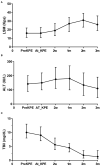A Nomogram Predicting the Prognosis of Children With Biliary Atresia After Hepatoportoenterostomy
- PMID: 33718307
- PMCID: PMC7943446
- DOI: 10.3389/fped.2021.641318
A Nomogram Predicting the Prognosis of Children With Biliary Atresia After Hepatoportoenterostomy
Abstract
Background: Although Kasai portoenterostomy (KPE) is performed timely for most children with biliary atresia (BA), the native liver survival (NLS) is still poor due to the progressive liver fibrosis. Many children have to receive liver transplantation (LT) within 2 years after KPE. Early prediction of the prognosis permits the implementation of prophylactic treatments for BA children. However, studies about the prediction are limited. Objective: The purpose of this study is to establish a nomogram to predict the prognosis of BA children within 2 years after KPE. Methods: The follow-up data of 151 BA children were retrospectively reviewed, and were randomly divided into a training cohort for constructing a nomogram (n = 103) and a validation cohort (n = 48). In the training cohort, patients were divided into Group A and Group B according to whether death or LT were observed within 2 years post-KPE. Multivariate Cox regression based on the baseline characteristics, liver function indicators and LSM (liver stiffness measurement) values at KPE and 3 months after KPE was utilized for the establishment of the nomogram in predicting the prognosis of BA within 2 years after KPE. The discrimination and calibration of the nomogram were internally and externally validated. Results: Fifty-six BA children were included in Group A and 47 were included in group B. Age at KPE, METAVIR score F4, LSM at 3 months, first onset of cholangitis within 3 months, and jaundice clearance time were the independent predictors for the prognosis of BA children within 2 years after KPE (all P < 0.05). The developed nomogram based on these independent predictors showed good discrimination and calibration by the internal and external validation. Its performance was better than each predictor in predicting the prognosis (all P < 0.05). Conclusions: The established nomogram based on the indicators from the first 3 months after KPE may be useful for predicting the prognosis of BA children within 2 years post-KPE and helpful for the consideration of LT.
Keywords: LSM; biliary atresia; kasai portoenterostomy; liver transplantation; nomogram; prognosis.
Copyright © 2021 Liu, Chen, Zhou, Li, Tang and Zhou.
Conflict of interest statement
The authors declare that the research was conducted in the absence of any commercial or financial relationships that could be construed as a potential conflict of interest.
Figures







Similar articles
-
Development and validation of a nomogram for predicting the clearance of jaundice in children with biliary Atresia after Kasai portoenterostomy.Langenbecks Arch Surg. 2025 Jun 11;410(1):185. doi: 10.1007/s00423-025-03759-9. Langenbecks Arch Surg. 2025. PMID: 40498365 Free PMC article. Clinical Trial.
-
A convenient nomogram for predicting early death or liver transplantation after the Kasai procedure in patients with biliary atresia.Langenbecks Arch Surg. 2024 Jan 8;409(1):30. doi: 10.1007/s00423-023-03216-5. Langenbecks Arch Surg. 2024. PMID: 38189999
-
Serum FGF19 combined with GGT and other biomarkers predicted native liver survival following Kasai portoenterostomy in early biliary atresia.J Gastroenterol. 2025 Jun;60(6):783-793. doi: 10.1007/s00535-025-02234-y. Epub 2025 May 5. J Gastroenterol. 2025. PMID: 40323393
-
Biomarkers for the diagnosis and post-Kasai portoenterostomy prognosis of biliary atresia: a systematic review and meta-analysis.Sci Rep. 2021 Jun 3;11(1):11692. doi: 10.1038/s41598-021-91072-y. Sci Rep. 2021. PMID: 34083585 Free PMC article.
-
Comparative study of open and laparoscopic Kasai portoenterostomy in children undergoing living donor liver transplantation for biliary atresia.Pediatr Surg Int. 2021 Dec;37(12):1683-1691. doi: 10.1007/s00383-021-04994-z. Epub 2021 Aug 28. Pediatr Surg Int. 2021. PMID: 34453589 Review.
Cited by
-
Predictors of biliary atresia outcome: Saudi National Study (2000 - 2018).Saudi J Gastroenterol. 2023 Sep-Oct;29(5):286-294. doi: 10.4103/sjg.sjg_512_22. Epub 2023 Mar 20. Saudi J Gastroenterol. 2023. PMID: 37787348 Free PMC article.
-
A Novel Model for Predicting the Clearance of Jaundice in Patients With Biliary Atresia After Kasai Procedure.Front Pediatr. 2022 Jan 31;10:837247. doi: 10.3389/fped.2022.837247. eCollection 2022. Front Pediatr. 2022. PMID: 35174110 Free PMC article.
-
A nomogram model based on preoperative grey-scale US features and routine serum biomarkers to predict the outcome of infants with biliary atresia after Kasai portoenterostomy.Front Pediatr. 2022 Oct 20;10:972855. doi: 10.3389/fped.2022.972855. eCollection 2022. Front Pediatr. 2022. PMID: 36340714 Free PMC article.
-
Development and validation of a nomogram for predicting the clearance of jaundice in children with biliary Atresia after Kasai portoenterostomy.Langenbecks Arch Surg. 2025 Jun 11;410(1):185. doi: 10.1007/s00423-025-03759-9. Langenbecks Arch Surg. 2025. PMID: 40498365 Free PMC article. Clinical Trial.
-
A convenient nomogram for predicting early death or liver transplantation after the Kasai procedure in patients with biliary atresia.Langenbecks Arch Surg. 2024 Jan 8;409(1):30. doi: 10.1007/s00423-023-03216-5. Langenbecks Arch Surg. 2024. PMID: 38189999
References
LinkOut - more resources
Full Text Sources
Other Literature Sources

